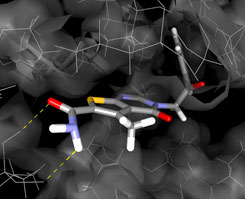|
P21-Activated Kinase 1 (PAK1) |
 | Ligand in PAK1 active site. Docking example from OTAVAchemicals
PAK1 focused library.
The detection of H-bonds between ligand and key PAK1 residues was used for the library preparation.
|
The impressive amount of basic research data available on Pak1, the possibility that Pak1 is amplified or overexpressed in tumors and Pak1 ability to modulate motility and cell survival functions have generated considerable anticipation in the field of cancer research that strategies targeting Pak1 may lead to the design of target specific drugs. The identification of unique interacting proteins and the availability of the crystal structure of Pak1 provide an ideal environment to develop novel small molecules or peptides to interfere with Pak1 functions. To date no specific drug targeting Pak1 activity has been developed, althrough several companies are currently attempting to produce such drugs that inhibit Pak1 kinase activity. Similarly, althrough siRNA methods of blocking Pak1 expression is shown to work, the clinical application is still in the very early phases of development. Recent data have suggested that blocking of Pak1 upstream activators may also be benefecial by indirectly blocking Pak activity. Growth factor-induced activation of Pak1 can be inhibited by the PDGF-R-specific inhibitor AG1478 or by the EGF receptor specific inhibitors (Iressa), monoclonal antibody 225 or the HER2 blocker trastuzumab (Herceptin). Therefore these compounds may be clinically useful in regulating Pak activity in growth factor-regulated tumors [50]. Small peptide molecules blocking Pak1 interactions with its substrates could also be used to inhibit Pak1 functions. The feasibility of this approach was demonstrated using a small peptide that blocked the adaptor protein NCK from binding to Pak1 and thus interfered with angiogenesis, Because Pak1 promotes cell survival, and its expression is deregulated in tumors, inhibition of its functions could induce apoptosis in cancer cells. The difference in the levels of expression of the Pak1 between normal and cancer cells could provide a therapeutic opportunity to use drugs to selectively inhibit cancer cells. In addition, drugs causing Pak1 inhibition in combination with other commonly used chemotherapy drugs, may have synergistic effects. The ability of Pak1 to phosphorylate estrogen receptor and induce expression of cyclin D1, both of which activities are widely deregulated in breast cancer, suggests that pak1 inhibitors may be useful in managing or at least delaying hormonal resistance seen in breast cancer. Becasue Pak1 plays an important role in modulating cytoskeleton and because many pathogens use cytoskeleton to enter cells and translocate there, Pak inhibitors may have a therapeutic role in interfering with these pathogenic viral infections. Emerging studies unraveling the novel roles of Pak1 signaling and the possible clinical potential of targeting Pak1 will continue to stimulate efforts to develop Pak1 inhibitors or blockers.
The focused libraries, including docking scores and drug-like properties, are available on request.
Feel free to contact us!
Vadlamudi RK, Kumar R. p21-activated kinase 1: an emerging therapeutic target. Cancer Treat Res. 2004;119:77-88.
|
 HOME
HOME ABOUT
ABOUT
 SERVICES
SERVICES
 PRODUCTS
PRODUCTS
 Targeted Libraries
Targeted Libraries
 Biochemicals
Biochemicals
 RESEARCH
RESEARCH
 DOWNLOADS
DOWNLOADS ORDERING
ORDERING
 CONTACTS
CONTACTS

